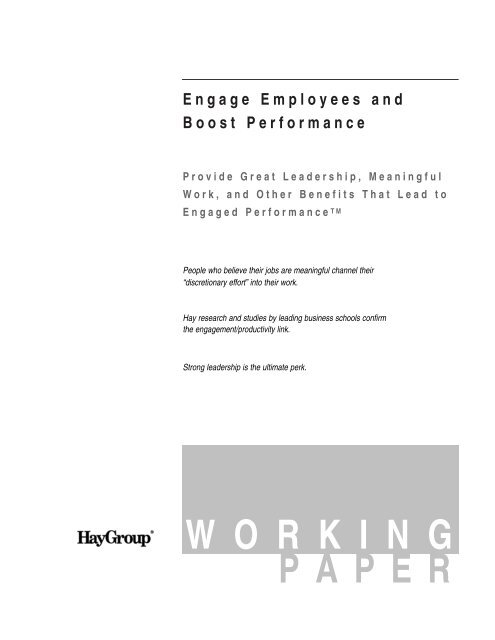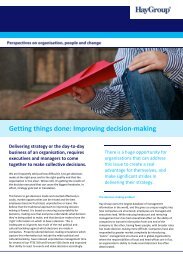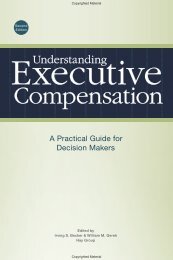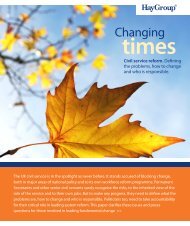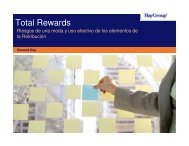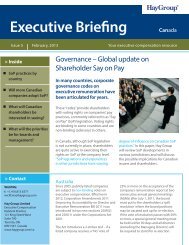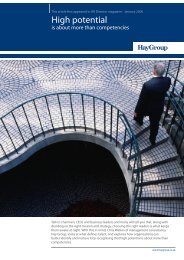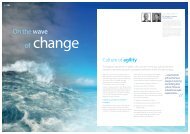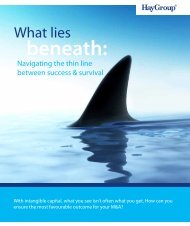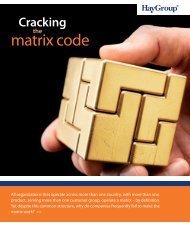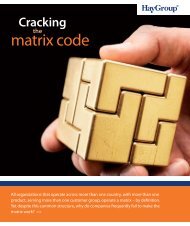Engage Employees and Boost Performance - Hay Group
Engage Employees and Boost Performance - Hay Group
Engage Employees and Boost Performance - Hay Group
Create successful ePaper yourself
Turn your PDF publications into a flip-book with our unique Google optimized e-Paper software.
<strong>Engage</strong> <strong>Employees</strong> <strong>and</strong><br />
<strong>Boost</strong> <strong>Performance</strong><br />
Provide Great Leadership, Meaningful<br />
Work, <strong>and</strong> Other Benefits That Lead to<br />
<strong>Engage</strong>d <strong>Performance</strong>TM People who believe their jobs are meaningful channel their<br />
“discretionary effort” into their work.<br />
<strong>Hay</strong> research <strong>and</strong> studies by leading business schools confirm<br />
the engagement/productivity link.<br />
Strong leadership is the ultimate perk.<br />
W O R K I N G<br />
PAPER
<strong>Engage</strong> <strong>Employees</strong> <strong>and</strong><br />
<strong>Boost</strong> <strong>Performance</strong><br />
<strong>Engage</strong>d <strong>Performance</strong> defined 3<br />
<strong>Engage</strong>d <strong>Performance</strong> <strong>and</strong> company valuations 5<br />
Why engagement is so important today 6<br />
Proof that engaged employees deliver results 6<br />
1. Inspiration <strong>and</strong> Values 8<br />
General Dynamics’ journey 8<br />
2. Future Growth/Opportunity 14<br />
3. Quality of Work 16<br />
Set high st<strong>and</strong>ards. 17<br />
Connect employees’ work to company goals. 18<br />
Make sure managers value employees’ work — <strong>and</strong> show it! 19<br />
4. Enabling Environment 19<br />
5. Work/Life Balance 21<br />
6. Tangible Rewards 23<br />
Make sure employees know your reward system is fair 23<br />
Create a culture of recognition 24<br />
Conclusion 25<br />
This working paper is the product of research conducted by<br />
Helen Murlis <strong>and</strong> Peggy Schubert.<br />
Copyright © 2001 <strong>Hay</strong> <strong>Group</strong>, Inc. All rights reserved.
1<br />
W O R K I N G<br />
PAPER<br />
Patrick, a call center team manager, was a “good” employee. He was prompt,<br />
did what he was asked <strong>and</strong> was liked by his subordinates. Ask Patrick how<br />
his job was going <strong>and</strong> he’d say, “Fine, they pay me pretty well.”<br />
Suddenly he resigned, citing no complaints <strong>and</strong> saying only that a competitor<br />
offered him slightly more money.<br />
But Patrick quit because he was disengaged. He, like millions of other<br />
employees, needed to believe his job was important, that he was contributing<br />
daily to the company. That his work had meaning.<br />
Former colleagues who talked to him six months later said he was a different<br />
person. His work was no different, but he clearly had passion for his<br />
job. His explanation? “My team’s hourly sales are 40 percent higher than<br />
before. But it's more than that. My first day I got ‘induction training,’ where<br />
they explained the company vision <strong>and</strong> values. My first week my boss,<br />
Stephanie, explained what I needed to do to meet the company’s goals <strong>and</strong><br />
act in sync with its values. She spent time coaching me on my managerial<br />
skills, something I needed badly.”<br />
Soon, Patrick received a “most promising newcomer” award. At the company<br />
picnic, Stephanie’s boss asked him how he was doing. After six months<br />
Patrick had an in-depth performance review where he <strong>and</strong> Stephanie c<strong>and</strong>idly<br />
discussed his performance <strong>and</strong> outlined training <strong>and</strong> career growth<br />
options for him.<br />
“I work extra hard when it’s needed because they really care about me,”<br />
Patrick told his ex-colleagues. “They even let me leave early twice a week to<br />
pick up my kids, which means a lot. But in the end it really comes down to<br />
leadership. My new company doesn’t just have a business model; it has a<br />
people model.”<br />
P<br />
atrick is not a star performer <strong>and</strong> his old company suffered little from<br />
his loss. But the conditions that led to his departure could be creating<br />
serious problems at that company. In fact, they may be hurting short-term<br />
profits <strong>and</strong> long-term company valuation even more than the loss of a dozen<br />
star performers.<br />
Here’s why. Patrick is part of the “engine room” of reliable but not outst<strong>and</strong>ing<br />
people organizations depend on to get things done. There are thous<strong>and</strong>s of
The more difficult challenge for<br />
companies is capturing the<br />
hearts <strong>and</strong> minds of good,<br />
reliable employees who are not<br />
stars but who are significantly<br />
more productive when engaged.<br />
2<br />
W O R K I N G<br />
PAPER<br />
“Patricks” (<strong>and</strong> “Patricias”) at every large private- or public-sector organization.<br />
Stars tend to be intrinsically motivated to begin with, plus they end up capturing<br />
most of the “prizes” companies offer — the most interesting work, big<br />
salary increases, promotions <strong>and</strong> bonuses. The more difficult challenge for<br />
companies is capturing the hearts <strong>and</strong> minds of good, reliable employees like<br />
Patrick who are not stars but who are significantly more productive when<br />
engaged.<br />
Research suggests many companies are not succeeding. A huge percentage of<br />
these “engine room” employees are disengaged. <strong>Hay</strong> Employee Attitude<br />
Surveys1 show that less than half of them feel they do interesting work. Just<br />
one-third feel they can advance, <strong>and</strong> only about the same percentage feel that<br />
better performance will lead to better pay.<br />
Figure 1: Difference in value-added discretionary performance<br />
between "superior" <strong>and</strong> "average" performers<br />
Type of Job<br />
Low-complexity jobs<br />
Moderate-complexity jobs<br />
High-complexity jobs<br />
Sales<br />
<strong>Performance</strong><br />
Difference<br />
19%<br />
32%<br />
48%<br />
48% - 120%<br />
Patrick’s new company did not lure him away with a substantially bigger salary.<br />
Nor did it use pay as a prime motivator once he arrived. Instead, it offered him<br />
a new psychological contract, one that successfully engaged him by letting him<br />
know that his contributions mattered. As a result, what mattered most to the<br />
company also mattered most to Patrick. The company’s reward: A 40 percent<br />
increase in Patrick’s <strong>and</strong> his team’s productivity.<br />
Your employees start every day with an extraordinary amount of energy, but<br />
the amount of “discretionary effort” that people apply to their jobs varies<br />
tremendously from employee to employee. One study showed that even in relatively<br />
simple jobs the difference in discretionary performance between superior<br />
<strong>and</strong> average workers was 19 percent (see Figure 1). 2 In complex jobs<br />
such as high-ticket industrial sales, the difference was as great as 120 percent.<br />
1 Based on data from <strong>Hay</strong> Insight’s employee opinion database, which contains survey responses<br />
obtained in the past four years from about one million employees at more than 330 companies.<br />
2 J.E. Hunter, F.L. Schmidt, <strong>and</strong> M.K. Judiesch,“Individual Differences in Output Variability as a<br />
Function of Job Complexity,” Journal of Applied Psychology 75: 28-42.
The offices with “engaged”<br />
employees were as much as 43<br />
percent more productive.<br />
3<br />
W O R K I N G<br />
PAPER<br />
What accounts for the broad gaps between great <strong>and</strong> average performers? The<br />
individual’s degree of motivation <strong>and</strong> engagement. <strong>Hay</strong> <strong>Group</strong>’s work with a<br />
professional services firm confirms the link. At 10 of the firm’s regional<br />
offices, we measured employees’ current levels of satisfaction using an <strong>Engage</strong>d<br />
<strong>Performance</strong> diagnostic survey. Professionals in the five “most engaged” offices<br />
generated $238,000 in revenue per consultant. Those in the five “least<br />
engaged” offices generated just $166,000 per consultant. In other words, the<br />
offices with “engaged” employees were as much as 43 percent more<br />
productive.<br />
The experience of General Dynamics Defense Systems (GDDS) in Pittsfield,<br />
Mass., shows how efforts to engage employees can yield results.<br />
In 1997 the company restructured <strong>and</strong> let go 550 of its 1,600 employees. The<br />
move devastated the workforce, <strong>and</strong> GDDS undertook an initiative to re-engage<br />
the hearts <strong>and</strong> minds of the remaining employees. As a result of these efforts<br />
(discussed in detail later), attrition in software engineering dropped from nearly<br />
20 percent in 1999 to 2.4 percent in 2001. Confidence in management shot<br />
up <strong>and</strong> commitment rose. Union grievances, which had cost the company as<br />
much as $10,000 each, dropped from 57 in 1999 to none in 2001, saving hundreds<br />
of thous<strong>and</strong>s of dollars. Best of all, earnings <strong>and</strong> profit margins doubled.<br />
<strong>Engage</strong>d <strong>Performance</strong> defined<br />
<strong>Engage</strong>d <strong>Performance</strong> is defined as a result that is achieved by stimulating<br />
employees’ enthusiasm for their work <strong>and</strong> directing it toward organizational<br />
success. This result can only be achieved when employers offer an implicit<br />
contract to their employees that elicits specific positive behaviors aligned<br />
with the organization’s goals.<br />
Getting <strong>Engage</strong>d <strong>Performance</strong> is not just about investing financially in employees<br />
through perks or pay hikes. It is about striking a new contract in which<br />
the organization invests emotionally in its workforce. In exchange, employees<br />
make a similar emotional investment, pouring their “discretionary effort” into<br />
their work <strong>and</strong> delivering superior performance. The new contract says,“We’ll<br />
make your job (<strong>and</strong> life) more meaningful. You give us your hearts <strong>and</strong> minds.”<br />
Is it an employer’s job to give meaning <strong>and</strong> passion to employees? “Absolutely,”<br />
says Rick Pope,Vice President of Finance <strong>and</strong> Administration at GDDS <strong>and</strong> a
The new [employment] contract<br />
says, “We’ll make your job (<strong>and</strong><br />
life) more meaningful. You give<br />
us your hearts <strong>and</strong> minds.”<br />
4<br />
W O R K I N G<br />
PAPER<br />
key player in the company’s turnaround. “Work is a significant part of people’s<br />
lives. When you meet someone new, the second or third question is ‘What do<br />
you do?’ It’s imperative that leaders give people meaning in their work<br />
because passionate employees get better results. If leaders can’t give people<br />
passion about their work, employees will find it somewhere else.”<br />
What engagement looks like<br />
University of Chicago psychologist Mihalyi Csikzentmihalyi, 3 who has studied<br />
the psychology of engaged workers at all levels, found that they create a hyperfocused<br />
state of mind. He calls it “flow.” People in flow are exhilarated <strong>and</strong> are<br />
remarkably unstressed even when doing challenging work. They lose themselves<br />
in a task they love <strong>and</strong> feel “out of time.” Their brains work efficiently<br />
<strong>and</strong> precisely. People are much more likely to be in flow while working than<br />
while involved in leisure activities. Moreover, flow occurs most often when<br />
tasks are tightly aligned with the person’s goals.<br />
What disengagement looks like<br />
At the end of each day union workers at an oil refinery dumped scrap metal in<br />
a pile to be discarded by a night crew. The day crew routinely co-mingled the<br />
scrap with pieces of new steel; as a result the night crew was tossing out the<br />
new steel as well. The practice was costing the company hundreds of dollars a<br />
day. When asked why they were throwing out new steel with scrap, the night<br />
workers replied,“Because we were told to clean up the area.” What they were<br />
doing made no sense, but they felt their duty was to do their job, not to make<br />
sense of things.<br />
“These workers were very smart people,” says a consultant who worked with<br />
the company. “Many of them had their own businesses on the side; one was<br />
the mayor of his town. There was a great deal of ‘discretionary effort’ in this<br />
workforce, <strong>and</strong> the company was getting none of it. One of the workers said<br />
to me,‘Basically, when we come here we check our brains at the gate.’”<br />
Contrast these workers with a payroll clerk at GDDS.<br />
On Tuesday, September 11, 2001, the day of the World Trade Center attack, she<br />
realized that employees weren’t going to get their pay checks on Thursday<br />
3 “Flow: The Psychology of Optimal Experience,” by Mihalyi Csikzentmihalyi. Harper <strong>and</strong> Row,<br />
New York, 1990.
Ultimately, delivering<br />
strategy is about hiring the<br />
right people <strong>and</strong> motivating<br />
them to deliver results.<br />
5<br />
W O R K I N G<br />
PAPER<br />
morning. Because planes were grounded, Federal Express wouldn’t be able to<br />
bring the checks from North Carolina. Without consulting anyone, she immediately<br />
arranged to have a courier service ship them 650 miles by truck. On<br />
Thursday morning, all employees received their checks on schedule. Her boss,<br />
Director of Accounting <strong>and</strong> Taxes Bill Craig, says “you just wouldn’t have seen<br />
that sort of behavior two years ago. It’s the result of the trust we’ve worked<br />
hard to get as a result of our change initiative.”<br />
<strong>Engage</strong>d <strong>Performance</strong> <strong>and</strong> company valuations<br />
If people are a key source of competitive advantage, their engagement <strong>and</strong> performance<br />
levels can make or break any organization’s strategy. Ultimately,<br />
delivering strategy is about hiring the right people <strong>and</strong> motivating them to<br />
deliver results. Employers therefore need to answer three questions:<br />
■ What types of people will help our organization succeed?<br />
■ Why would the best people I need for my business want to work here?<br />
■ How should we treat our people so they deliver peak performance?<br />
These questions cut to the heart of engaged performance, which we believe is<br />
a factor influencing company valuations. A recent survey by Ernst <strong>and</strong> Young4 of institutional investors showed that 35 percent of their decisions now hinge<br />
on nonfinancial factors. The investors’ top-ranked nonfinancial factor was “execution<br />
of corporate strategy” — which is to a large extent about management’s<br />
ability to motivate people <strong>and</strong> channel their “discretionary effort.” Companies<br />
ignore at great risk the elements that contribute to the engaged performance<br />
of their employees.<br />
The same is true in the public sector where, increasingly, management quality<br />
<strong>and</strong> staff morale are subject to rigorous scrutiny <strong>and</strong> factored into development<br />
<strong>and</strong> funding decisions.<br />
4 “Measures that Matter: An Exploratory Investigation of Investors’ Information Needs <strong>and</strong> Value<br />
Priorities,” by Sarah Mavrinac <strong>and</strong> Tony Siesfeld. Ernst & Young Center for Business Innovation <strong>and</strong><br />
the Organization for Economic Cooperation <strong>and</strong> Development, 1998.
6<br />
W O R K I N G<br />
PAPER<br />
Why engagement is so important today<br />
Organizational working relationships have changed since many of today’s CEOs<br />
started work. Before the early 1990s recession an unspoken contract existed<br />
between employer <strong>and</strong> employee: Commit to working here for the long term<br />
<strong>and</strong> we will offer you job security, good pay <strong>and</strong> promotions. But the recession<br />
led to reengineering <strong>and</strong> downsizing, breaking that contract.<br />
Moreover, there is a new mindset among young people who began their<br />
careers in the boom years after the 1990 recession. They do not expect lifetime<br />
employment with a single employer. They consider personal fulfilment in<br />
their work as a birthright — <strong>and</strong> this is extremely unlikely to change during<br />
economic downturn. They will just take different options — for example, free<br />
agency or self employment — rather than work for a low-reputation employer.<br />
Many organizations that have not recognized this significant change in agenda<br />
are struggling to cope. Frustrated executives say, we raised their salaries, gave<br />
them performance-based incentives <strong>and</strong> instituted flextime — but we’re still<br />
losing good employees <strong>and</strong> having productivity problems. What do these<br />
people want anyway?<br />
The dem<strong>and</strong>s of employees are beginning to mirror the dem<strong>and</strong>s customers<br />
now make on businesses. In the past two decades, customers have become<br />
increasingly dem<strong>and</strong>ing <strong>and</strong> businesses have responded by forging new “value<br />
propositions” for customers, usually through value-added service.<br />
<strong>Hay</strong> believes that you have to start thinking about the people you employ the<br />
same way you think about customers. That means offering them a rewarding<br />
environment to work in, not just financial rewards.<br />
Proof that engaged employees deliver results<br />
Will engaged employees really deliver improved business results?<br />
Analysis shows that Fortune magazine’s “America’s Most Admired Companies”<br />
increased stock appreciation 50 percent over their peers because they<br />
instituted pro-employee measures.
People management practices<br />
were a better predictor of<br />
company performance than<br />
strategy, technology or<br />
research <strong>and</strong> development.<br />
7<br />
W O R K I N G<br />
PAPER<br />
Organizational effectiveness research at the Institute of Work Psychology at<br />
Sheffield University in the United Kingdom showed that among the manufacturing<br />
companies studied, good management practices could account for an 18<br />
percent improvement in productivity <strong>and</strong> a 19 percent improvement in profitability.<br />
5 People management practices were a better predictor of company<br />
performance than strategy, technology or research <strong>and</strong> development, the<br />
researchers concluded.<br />
TM<br />
Figure 2: <strong>Engage</strong>d <strong>Performance</strong> Model<br />
Competitive Pay<br />
Good Benefits<br />
Incentives for Higher<br />
<strong>Performance</strong><br />
Ownership Potential<br />
Recognition Awards<br />
Fairness of Reward<br />
Learning <strong>and</strong><br />
Development Beyond<br />
Current Job<br />
Career Advancement<br />
Opportunities<br />
<strong>Performance</strong><br />
Improvement &<br />
Feedback<br />
Perception of the Value of Work<br />
Challenge/Interest<br />
Achievement<br />
Tangible<br />
Rewards<br />
Future<br />
Growth/<br />
Opportunity<br />
Quality of Work<br />
Enabling<br />
Environment<br />
Physical Environment<br />
Tools <strong>and</strong> Equipment<br />
Job Training (Current Position)<br />
Information <strong>and</strong> Processes<br />
Safety/Personal Security<br />
6 Core Elements<br />
Freedom & Autonomy<br />
Workload<br />
Quality of Work Relationships<br />
Work/Life<br />
Balance<br />
Inspiration<br />
Values<br />
Supportive Environment<br />
Recognition of Life Cycle<br />
Needs/Flexibility<br />
Security of Income<br />
Social Environment<br />
Quality of Leadership<br />
Organizational Values<br />
<strong>and</strong> Behaviors<br />
Reputation of<br />
Organization<br />
Risk Sharing<br />
Recognition<br />
Communication<br />
<strong>Hay</strong> <strong>Group</strong> — which has helped dozens of leading international companies<br />
<strong>and</strong> many major public service organizations create sustained performance by<br />
engaging their workforce — has identified six motivational drivers that help<br />
create an engaged workplace <strong>and</strong> influence results. They are: Inspiration <strong>and</strong><br />
Values, Future Growth/Opportunity, Quality of Work, Enabling Environment,<br />
Work/Life Balance <strong>and</strong> Tangible Rewards (see Figure 2).<br />
Not all of these drivers will matter equally to everyone. You need to collect<br />
specific data to identify the most significant needs within the different demographic<br />
segments of your workforce. Only then can you formulate high-impact<br />
programs to meet employees’ needs <strong>and</strong> effectively engage them. One-size-fitsall<br />
no longer works as an HR or reward strategy.<br />
5 Cited in “The Change Agenda,” by Simon Caulkin. Published by the Chartered Institute of<br />
Personnel <strong>and</strong> Development (CIPD), 2001.
Inspirational leadership is<br />
the ultimate perk.<br />
8<br />
W O R K I N G<br />
PAPER<br />
1. Inspiration <strong>and</strong> Values<br />
W<br />
ould you channel your “discretionary effort” into your work if you<br />
believed that your organization’s leadership was second-rate or that its<br />
values were either off-base or ill-defined?<br />
You probably wouldn’t, regardless of how much money you made, or how<br />
good your benefits <strong>and</strong> other perks were. That’s why “Inspiration <strong>and</strong> Values” is<br />
the most important of the six drivers in our <strong>Engage</strong>d <strong>Performance</strong> model.<br />
Inspirational leadership is the ultimate perk. In its absence, delivering on the<br />
other five elements of the <strong>Engage</strong>d <strong>Performance</strong> model is unlikely to engage<br />
employees.<br />
General Dynamics’ journey<br />
General Dynamics Defense Systems is a company that learned to listen as carefully<br />
to its employees as it did to its customers, making dramatic changes in the<br />
way it managed itself. As a result, it engaged its workforce <strong>and</strong> achieved exceptional<br />
results. But it was not easy, <strong>and</strong> the twists <strong>and</strong> turns on its journey offer<br />
insights for other companies broaching major change initiatives.<br />
Stage One: Shooting in the dark<br />
In the year after GDDS laid off 550 workers, it took steps to improve leadership<br />
quality <strong>and</strong> revitalize its workforce. These initiatives were part of a program<br />
called “Workplace 2000” <strong>and</strong> included various efforts to improve the<br />
workplace, such as flextime <strong>and</strong> mentoring. Top management felt it was making<br />
progress with these measures until a July 1999 employee attitudes survey<br />
revealed that workers were still deeply dissatisfied <strong>and</strong> had little confidence in<br />
management. One finding in particular stunned the executive team: more<br />
than 70 percent of GDDS employees believed the company tolerated poor<br />
performance.<br />
How could this be? top management wondered. We made huge investments<br />
in Workforce 2000 to improve the company. What do these people want?<br />
“The initial reaction from the management team was ‘Fire all the bastards!<br />
They just don’t get it,’” recalls Rick Pope, the head of finance. “Then we realized<br />
that maybe we were part of the problem.”
“The initial reaction from the<br />
management team was ‘Fire all<br />
the bastards!’ Then we<br />
realized that maybe we were<br />
part of the problem.”<br />
9<br />
W O R K I N G<br />
PAPER<br />
Director of Human Resources John Lipa says this finding was “the single most<br />
galvanizing piece of data we saw in this entire process. It really showed that<br />
our leaders didn’t know how to talk to people. We were gathering sound<br />
bites, but we weren’t listening. And we shouldn’t have been shocked. If we’d<br />
really been in tune with our workforce, that number wouldn’t have surprised<br />
anyone.”<br />
The lesson learned: “Implementing ‘point’ solutions doesn’t work,” says Pope.<br />
“Since they weren’t tied together, employees perceived them as just a bunch of<br />
management initiatives. Development needs weren’t identified. There was no<br />
training. <strong>Employees</strong> didn’t see the efforts as part of a holistic system.”<br />
Stage Two: Focusing on processes<br />
GDDS knew it couldn’t just ask people to work harder. “We had to find a way<br />
to get them engaged,” says Pope. “The main thing we saw at that point was the<br />
need to give them clarity. They needed to underst<strong>and</strong> how their individual role<br />
fit in the gr<strong>and</strong> scheme of things.”<br />
To help employees see the importance of their roles, GDDS created a “Learning<br />
Map,” a graphical representation showing the link between every employee’s<br />
day-to-day tasks <strong>and</strong> the firm’s business objectives. For example, the map could<br />
show a software engineer that if he speeded up cycle time on a project the<br />
company could cut internal costs, thereby enhancing the saleforce’s negotiating<br />
leverage on bids. That would increase company sales <strong>and</strong> profits. The engineer<br />
had a direct line of sight to business outcomes, <strong>and</strong> his performance metrics<br />
were directly tied to the organization’s financial results.<br />
Management began conducting quarterly sessions at all levels of the organization.<br />
At these gatherings senior staff would reveal financial results, both good<br />
<strong>and</strong> bad, <strong>and</strong> link them to employees’ individual goals.<br />
These process-based efforts showed results a year later (see Figure 3). In June<br />
2000 employees gave management high marks for “clarity” (74), meaning that<br />
management had set a clear mission <strong>and</strong> direction <strong>and</strong> had defined clear roles.<br />
The Learning Map had done its job well. <strong>Employees</strong> believed the company<br />
knew where it was going.
In June 2000, efforts such<br />
as the Learning Map raised<br />
Clarity to a satisfactory<br />
level (74). But Commitment<br />
(45) was still far too low.<br />
10<br />
W O R K I N G<br />
PAPER<br />
But the June 2000 climate survey also showed disappointingly low levels of<br />
employee commitment, a key measure of pride in belonging to an organization.<br />
Committment scored just 45 on a scale of one to 100. Again, top management<br />
was shocked. Despite employees’ sense that they knew where the company<br />
was going, <strong>and</strong> where they fit in, employees were not engaged.<br />
100<br />
80<br />
60<br />
40<br />
20<br />
0<br />
Figure 3: GDDS Organizational Climate Survey, June 2000<br />
70<br />
Flexibility<br />
80<br />
Responsibility<br />
St<strong>and</strong>ards<br />
Rewards<br />
Stage Three: Focusing on people — getting it right<br />
73<br />
Clarity<br />
Commitment<br />
In June 2000 General Dynamics’ senior staff received 360-degree feedback (i.e.,<br />
from bosses, peers <strong>and</strong> subordinates) using a managerial styles inventory. It<br />
showed them what range of styles were commonly being used <strong>and</strong> provided<br />
insights into why commitment levels were lower than expected (see Figure 4).<br />
There was some good news — the aggregate Authoritative score (60.7) for all<br />
managers combined was relatively high, confirming the top management team<br />
was indeed providing direction. And the Coercive score (31.6) was reasonably<br />
low, suggesting that managers got results from employees without using comm<strong>and</strong>-<strong>and</strong>-control<br />
tactics.<br />
But the Affiliative score (37.1) <strong>and</strong> the Coaching score (39) were way too low.<br />
Coaching includes helping employees identify their strengths <strong>and</strong> weaknesses<br />
in light of their aspirations. The Affiliative style involves listening to employees,<br />
giving positive feedback <strong>and</strong> offering rewards for “who you are” as much as<br />
62<br />
74<br />
45
In June 2000 senior staff scored<br />
high on the Authoritive style,<br />
indicating they were giving clear<br />
direction on company goals <strong>and</strong><br />
values. However, both the<br />
Affiliative <strong>and</strong> Coaching styles<br />
were low, suggesting senior staff<br />
was not listening to employees,<br />
recognizing achievement, or<br />
coaching employees.<br />
11<br />
W O R K I N G<br />
PAPER<br />
“what you’ve done.” GDDS employees were telling their bosses they needed<br />
more individual human contact in the form of dialogue, feedback <strong>and</strong><br />
recognition.<br />
Pope says the executive team realized the June survey was telling them that<br />
action was needed not just to change the organization but to change themselves.<br />
“We were intellectually smart enough once we saw the data to see that<br />
we needed to change our approach,” says Pope. “Rather than focus on processes,<br />
we needed to focus on people. And it started with the executive team.”<br />
100<br />
80<br />
60<br />
40<br />
20<br />
0<br />
Figure 4: GDDS Managerial Styles Inventory, June 2000<br />
31.6<br />
Coercive<br />
60.7<br />
Authoritative<br />
37.1<br />
Affiliative<br />
Democratic<br />
Pacesetting<br />
Coaching<br />
The eight members of the executive team received individual coaching. The<br />
process was difficult for them. “You rise to a position of authority <strong>and</strong> think<br />
you’re good enough,” says John Lipa, the director of human resources. “But<br />
then that data hits you in the face <strong>and</strong> you recognize that subtle things are preventing<br />
you from being really effective.”<br />
The executive team members were remarkably open about their shortcomings.<br />
Then-vice-president of engineering Mike Tweed-Kent acknowledged in the<br />
company newsletter that “my direct reports felt that I could be more empathetic<br />
— that I was too quick to find a solution for problems <strong>and</strong> issues rather than<br />
taking time to listen <strong>and</strong> underst<strong>and</strong>.” Rick Pope said he could improve “managing<br />
situations where people expressed different views” <strong>and</strong> that he needed<br />
to “spend more time communicating <strong>and</strong> being visible.”<br />
50.9<br />
63.8<br />
39.0
The June 2001<br />
Managerial Styles survey<br />
showed dramatic<br />
increases in the<br />
Affiliative <strong>and</strong> Coaching<br />
styles, indicating that<br />
senior staff was treating<br />
employees more as<br />
unique individuals.<br />
12<br />
W O R K I N G<br />
PAPER<br />
That top management was talking this way to employees had a huge impact.<br />
“It showed that senior management was committed to making changes,” says<br />
Gloria Forbes, a principal HR representative. “They recognized it had to happen<br />
from the top down, <strong>and</strong> they were walking the talk. It really improved<br />
morale.”<br />
Forbes said her own boss would gather his team together <strong>and</strong> ask them point<br />
blank how he was doing. Forbes says: “He gave us a report card <strong>and</strong> said,<br />
‘grade me.’ And he made it clear it was okay to be c<strong>and</strong>id.”<br />
100<br />
80<br />
60<br />
40<br />
20<br />
0<br />
Figure 5: Changes in Managerial Styles, June 2000-June 2001<br />
31.6<br />
23.6<br />
Coercive<br />
60.7<br />
80.0<br />
Authoritative<br />
37.1<br />
70.1<br />
Affiliative<br />
Democratic<br />
Pacesetting<br />
Coaching<br />
After a year of intense management development at all company levels, a June<br />
2001 survey showed that employees perceived significant positive changes in<br />
the managerial styles of General Dynamics leaders (see Figure 5). Senior<br />
staffers became considerably better at articulating the company’s vision. They<br />
also tilted more toward democracy: They asked for input from others, sought<br />
consensus more often <strong>and</strong> became less coercive.<br />
But the biggest gains were in their use of the Affiliative <strong>and</strong> Coaching styles.<br />
The Affiliative score shot up from 37.1 to 70.1, suggesting that the senior staff<br />
was really listening to employees <strong>and</strong> encouraging them through positive feedback.<br />
The Coaching score rose from 39 to 69.8, indicating that GDDS leaders<br />
were engaging in meaningful dialogue with employees about goals, performance<br />
<strong>and</strong> future opportunities.<br />
50.9<br />
59.1<br />
2000<br />
63.8 63.6<br />
39.0<br />
2001<br />
69.8
As a result of changes in<br />
Managerial Style,<br />
employee Commitment<br />
soared from 45 to 70 in<br />
just one year.<br />
13<br />
W O R K I N G<br />
PAPER<br />
<strong>Employees</strong> noticed. “When I first arrived here in 1999 performance measurement<br />
was very inconsistent,” says Forbes. “It was done on an annual basis, if at<br />
all. Today, managers dialogue with employees several times a year. And the<br />
conversations are very different. They talk about performance, raising issues<br />
before they become problems. They talk about changing the culture. They talk<br />
about our careers.”<br />
All of which has engaged employees. An administrative assistant to a vice president<br />
says that as a result of management’s new behavior, she feels a greater<br />
sense of ownership in her job. “I dress more professionally than I used to, <strong>and</strong><br />
when I answer a customer call I no longer just give a yes or a no,” she says. “I<br />
ask questions <strong>and</strong> really try to help the person on the other end of the line.”<br />
100<br />
80<br />
60<br />
40<br />
20<br />
0<br />
Figure 6: Organizational Climate Changes, June 2000-June 2001<br />
70<br />
78<br />
Flexibility<br />
Responsibility<br />
St<strong>and</strong>ards<br />
Changes in managerial style improved climate<br />
How did these management changes affect employee commitment?<br />
Significantly. In June 2001, a year after the initial climate survey, GDDS surveyed<br />
employees again <strong>and</strong> commitment levels had shot up 25 points, from 45<br />
to 70 (see Figure 6).<br />
The key: Spend time with employees<br />
80<br />
92<br />
73<br />
82<br />
Rewards<br />
Clarity<br />
Commitment<br />
John Lipa believes leaders need to underst<strong>and</strong> that “interface time” is the key to<br />
providing “Inspiration <strong>and</strong> Vision.” He says:“Managers can’t engage people by<br />
making announcements. They have to invest time in developing people.”<br />
62<br />
78<br />
74<br />
2000<br />
80<br />
45<br />
2001<br />
70
“Managers can’t engage people<br />
by making announcements.<br />
They have to invest time<br />
in developing people.”<br />
14<br />
W O R K I N G<br />
PAPER<br />
Lipa recalls a “tough conversation” he had with an employee who came to ask<br />
for a promotion. “He had this quizzical look on his face when I told him he<br />
wasn’t going to get it,” says Lipa. “So I asked him ‘what don’t you underst<strong>and</strong>?’<br />
<strong>and</strong> I coached him on the changes he’d have to make to get where he wanted<br />
to go. I explained that the bar had been raised. You have to compete for jobs<br />
more than in the past. That conversation took an extra 20 minutes. It took<br />
him a long time to get it. But as a manager you’ve got to take the time. That’s<br />
what people respond to.”<br />
2. Future Growth/Opportunity<br />
A<br />
recent <strong>Hay</strong> study on retention showed that the primary reason employees<br />
leave is that they are not adequately using their skills. <strong>Employees</strong><br />
think long-term about their careers <strong>and</strong> want to know that they are using their<br />
skills to advance.<br />
In the context of <strong>Engage</strong>d <strong>Performance</strong>, this should be no surprise. <strong>Engage</strong>d<br />
<strong>Performance</strong> is about instilling enthusiasm <strong>and</strong> passion for work, to the point<br />
where people find such meaning in their jobs that they no longer compartmentalize<br />
their “work” <strong>and</strong> “private” lives. Meaningful answers to questions<br />
such as “How am I doing?” <strong>and</strong> “What are my long-term prospects with this<br />
company?” <strong>and</strong> “What learning <strong>and</strong> development opportunities can you offer<br />
beyond my current job?” are essential to engaging people in their work.<br />
What if jobs don’t appear to offer enough opportunity? Create it!<br />
In 2000 Singapore’s Ministry of Education faced a crisis when it realized it<br />
could lose a third of its teachers within five years. Instead of looking at conventional<br />
reward-based solutions, the Ministry asked a sample of its 24,000<br />
teachers for input on what would attract people to <strong>and</strong> keep them in the<br />
teaching profession. Career prospects were a critical issue. Many felt that if<br />
they were not in management, they had little opportunity to advance. The<br />
Ministry came up with a creative solution, establishing three new career tracks,<br />
or “fields of excellence,” that teachers could pursue. Those who wanted to stay<br />
in teaching could pursue a “Master Teacher” accreditation. Teachers who wanted<br />
to develop in a specific area such as educational psychology could work to<br />
become “Senior Specialists.” And those who wanted to lead could follow a
Feedback is key to giving<br />
employees a sense of where<br />
they’re going, but many<br />
organizations are remarkably<br />
bad at giving it.<br />
15<br />
W O R K I N G<br />
PAPER<br />
management track that ranges from the heads of departments to the top of the<br />
Ministry. The result: teaching has become a more attractive career. Attrition<br />
has slowed.<br />
Feedback is key to giving employees a sense of where they’re going, but many<br />
organizations are remarkably bad at giving it. A <strong>Hay</strong> Employee Attitudes Survey<br />
shows that only about half of employees are satisfied with the feedback they<br />
get from their bosses (see Figure 7). Managers don’t give effective feedback for<br />
a variety of reasons. Some are too inexperienced to realize its importance.<br />
Others know it’s important but don’t know how to give it. And many, unable<br />
to bear the unpleasantness of giving negative feedback, avoid it. Then they<br />
wonder why their staffs are alienated <strong>and</strong> lack motivation.<br />
Figure 7: <strong>Performance</strong> Improvement <strong>and</strong> Feedback<br />
Percent Favorable<br />
100%<br />
80%<br />
60%<br />
40%<br />
20%<br />
0<br />
56%<br />
50%<br />
Middle Professional/<br />
Managers Technical<br />
Hourly<br />
How do you rate your supervisor on letting you know what kind of<br />
job you are doing?<br />
But feedback is perhaps the best tool in the boss’ arsenal for decoding strategy<br />
<strong>and</strong> improving execution. What’s more, employees clearly crave it. A major<br />
professional services firm in the U.K. that hires high-caliber university graduates<br />
was losing too many of them <strong>and</strong> wanted to know why. In a focus group<br />
conducted for the firm the problem became crystal clear: “The performance<br />
management system promised feedback after one year, but we want it after<br />
three months!” said the recruits. “We want to know how we’re doing. Are we<br />
fitting in? Do we underst<strong>and</strong> the culture? What can we be doing better? We<br />
can take tough feedback as long as it helps us grow <strong>and</strong> build confidence.”<br />
52%<br />
Clerical<br />
46%
To guarantee that employees<br />
receive feedback, a company<br />
must create systems that<br />
managers find easy to use.<br />
16<br />
W O R K I N G<br />
PAPER<br />
To guarantee that employees receive feedback, a company must create systems<br />
that managers find easy to use. Amgen, a biotechnology company based in<br />
Thous<strong>and</strong> Oaks, California, recognizes the importance of helping employees<br />
manage their careers. Once a year, the company requires that all managers sit<br />
down with their subordinates <strong>and</strong> have a “non-performance-related” discussion.<br />
The idea is simply to talk to them about their careers. Are they happy? Are<br />
they using their skills <strong>and</strong> abilities to the fullest extent? Are they moving in the<br />
direction they want to go?<br />
As part of its initiative to engage employees, GDDS instituted “Individual<br />
Training <strong>and</strong> Development Plans” (ITDPs). Every employee has such a plan,<br />
which connects training to goals. Managers meet with employees four times<br />
annually to discuss four different topics, most of which touch upon ITDPs:<br />
salary, training <strong>and</strong> development, career planning <strong>and</strong> goal setting.<br />
HR Director Lipa says managers at GDDS have been good about making sure<br />
the training gets done. His records show that 98 percent of the 3,600 training<br />
courses <strong>and</strong> other “development inputs” were completed in the first year of the<br />
program. “This sends the message to employees that we’re serious about developing<br />
them,” Lipa says.<br />
Managers too often get caught up in day-to-day tasks <strong>and</strong> see employees’ work<br />
merely as a means to accomplish the organization’s objectives. They forget that<br />
for employees, their daily work is a means of fulfilling career aspirations. Smart<br />
managers underst<strong>and</strong> the need to align the company’s objectives with the<br />
employee’s long-term career goals. That’s how you engage employees.<br />
3. Quality of Work<br />
R<br />
ecently, a solar energy firm placed the following recruiting ad in a<br />
London newspaper:<br />
Belief in what you’re doing is perhaps the most important perk of them<br />
all, so if you looked at the salary offered before reading about the job,<br />
perhaps we’re not right for you.<br />
A bomb disposal expert in Britain who had taken over for a colleague killed by<br />
an IRA bomb was asked by a reporter: “You are risking death doing this <strong>and</strong><br />
only getting paid an army salary. Why do you do such an awful job?”
<strong>Engage</strong> people by getting<br />
them to believe they are<br />
building cathedrals, not<br />
merely laying bricks.<br />
17<br />
W O R K I N G<br />
PAPER<br />
“It isn’t an awful job,” the bomb expert replied.“It’s a very worthwhile job<br />
<strong>and</strong> the danger is worth it to save lives. People respect what I do!”<br />
In each example a sense of mission <strong>and</strong> intrinsic value is built into the job. So<br />
is the line of sight to a meaningful objective. For most employees, however,<br />
the intrinsic value of their work is harder to gauge. And the line of sight to a<br />
meaningful goal is often fuzzy. A key leadership task is to elevate the stature of<br />
apparently mundane work, to engage people by getting them to believe they<br />
are building cathedrals, not merely laying bricks. How can organizations do<br />
that?<br />
Set high st<strong>and</strong>ards.<br />
Pride in work gives employees a sense of purpose <strong>and</strong> meaning. It is also a<br />
huge motivator. One of the best ways to instill pride in a workforce is to set<br />
high st<strong>and</strong>ards <strong>and</strong> challenge people to meet them. As obvious as this may<br />
seem, initially we saw that at GDDS 70 percent of employees felt the company<br />
tolerated poor performance. According to the <strong>Hay</strong> Employee Attitudes Survey,<br />
typical companies are better than GDDS but not by much. About half of<br />
employees say their organizations’ st<strong>and</strong>ards are too low (see Figure 8).<br />
One way to dispel these perceptions, <strong>and</strong> give people a sense of pride in their<br />
work, is to invest in measures that ensure high quality. GDDS, for example,<br />
implemented a Six Sigma program back in 1999. Like Total Quality Management,<br />
Six Sigma is a methodology for improving processes <strong>and</strong> the quality of<br />
outcomes. It gives workers the freedom <strong>and</strong> autonomy to identify problems<br />
<strong>and</strong> develop their own solutions.<br />
GDDS has trained more than 90 engineers in the new methodology. Their attitudes<br />
have changed dramatically. Before the advent of Six Sigma, when engineers<br />
spotted a problem “a h<strong>and</strong>ful of engineers would define the problem <strong>and</strong><br />
send their recommendations to senior management,” says a quality assurance<br />
engineer. “Then we’d just shrug our shoulders <strong>and</strong> wait for senior management<br />
to respond.”<br />
Now, engineers have the authority <strong>and</strong> freedom to solve problems themselves.<br />
“I recently suggested ways to improve our process of writing proposals to
18<br />
W O R K I N G<br />
PAPER<br />
customers,” says the engineer proudly. “Management quickly told us to go<br />
ahead <strong>and</strong> do it. So we figured out how to do two iterations instead of four to<br />
get to a final draft. That saves a lot of time <strong>and</strong> money.” It’s also deeply satisfying<br />
to the engineers, who pursued a higher st<strong>and</strong>ard of excellence <strong>and</strong> met<br />
their objective.<br />
Figure 8: Tolerating Poor <strong>Performance</strong><br />
Percentage of team members who answered "yes"<br />
100%<br />
80%<br />
60%<br />
40%<br />
20%<br />
0<br />
50%<br />
Middle Managers<br />
Professional/Technical<br />
Hourly<br />
Connect employees’ work to company goals.<br />
One goal of the Six Sigma program was to streamline processes <strong>and</strong> cut costs<br />
to improve negotiating leverage when the company bid for contracts.<br />
<strong>Employees</strong>, who saw the direct connection between their activities <strong>and</strong> company<br />
profitability, took on the challenge. In October 2000 the company newsletter<br />
published a list of Six Sigma successes, naming team members who took it<br />
upon themselves to cut costs. One group charged with streamlining the failure-reporting<br />
process reduced the need for documentation by 80 percent <strong>and</strong><br />
saved the company $80,000 annually. Another team reviewed telecom contracts,<br />
chasing out $100,000 in costs while improving service. Another group<br />
reduced cycle time in the material-review process from nine days to four-<strong>and</strong>-ahalf,<br />
slashing labor costs 20 percent. None of this would have happened if<br />
employees hadn’t had a clear line of sight to the company’s objectives.<br />
43%<br />
Do you agree that poor performance is usually not tolerated at your<br />
company?<br />
44%
“People don’t leave companies,”<br />
one of our clients said.<br />
“They leave bosses.”<br />
19<br />
W O R K I N G<br />
PAPER<br />
Make sure managers value employees’<br />
work — <strong>and</strong> show it!<br />
<strong>Employees</strong>’ most important relationship is with their line manager, research<br />
shows. “People don’t leave companies,” one of our clients said.“They leave<br />
bosses.” Imagine working for a boss who does not believe what you do is<br />
important. Even the bomb disposal expert would not continue risking his life<br />
if he felt his superior officer did not respect what he did.<br />
In our work with a major health care organization we asked a hospital porter<br />
what he liked about the job. His answer: Variety <strong>and</strong> helping people. There<br />
are some routine things, but you are always seeing different people, reassuring<br />
the nervous ones going for treatment, making sure the supplies arrive<br />
when they should. I know the place can’t function without people like me<br />
<strong>and</strong> we can do a lot to make the place cheerful. I feel part of a team <strong>and</strong><br />
my boss always thanks me when I have had to do something nasty or<br />
difficult.<br />
A hospital porter has a repetitive, low-status job. Why does this man like it so<br />
much? Because his boss continually reinforces the importance of his role,<br />
which is to help patients get better. He channels his “discretionary effort” into<br />
his work because his boss believes his work is important, <strong>and</strong> tells him so<br />
regularly.<br />
Employers around the world know how much job satisfaction matters. Yet <strong>Hay</strong><br />
<strong>Group</strong> research consistently finds that not enough of them actually deliver it. A<br />
<strong>Hay</strong> Employee Attitudes survey found that 75 percent of managers feel they<br />
have interesting <strong>and</strong> challenging work. But only 56 percent of professional <strong>and</strong><br />
technical employees <strong>and</strong> fewer than 40 percent of clerical <strong>and</strong> hourly employees<br />
feel the same way.<br />
Companies have a lot of work to do.<br />
4. Enabling Environment<br />
M<br />
anagers who control organizational resources underst<strong>and</strong> the inherent<br />
conflict in that job. On the one h<strong>and</strong>, they know that an enabling environment<br />
— which includes a friendly, well-designed, safe physical space; good<br />
equipment; effective communication; <strong>and</strong> good training — will help improve
Most companies, because<br />
they have no systematic<br />
way to determine where<br />
the real “pain” is in their<br />
workforces, often rely on<br />
the “squeaky-wheel-gets-<br />
the-grease” method of<br />
dealing with requests.<br />
20<br />
W O R K I N G<br />
PAPER<br />
productivity. On the other h<strong>and</strong>, resources to create that environment are limited<br />
<strong>and</strong> allocation decisions are tough. My computer is too slow. I need training.<br />
My office is too cold (or hot). I need an ergonomic chair. We need a<br />
security guard in the building after working hours. Shouldn’t we put pictures<br />
on the walls? Why don’t we have a fitness center?<br />
An analogy to marketing is apt here. Marketers would ideally use all available<br />
media to promote their products. Because that would be prohibitively expensive,<br />
they rely on market knowledge <strong>and</strong> sophisticated analytical tools to make<br />
strategic choices. Those with the best information, <strong>and</strong> the best analysis, get<br />
the biggest bang for their buck.<br />
Employers need to think the same way about investments to create an<br />
enabling environment.<br />
Our research has shown that most companies, because they have no systematic<br />
way to determine where the real “pain” is in their workforces, often rely on<br />
the “squeaky-wheel-gets-the-grease” method of dealing with requests. They give<br />
in to the dem<strong>and</strong>s of individuals or groups that are persistent <strong>and</strong> vocal, rather<br />
than doing what’s best for the organization. In consumer marketing, this is the<br />
equivalent of making product changes in response to feedback from early<br />
adopters or people who call in <strong>and</strong> write letters; chances are neither group<br />
represents all consumers.<br />
To create an enabling environment in a cost-effective way, employers have to<br />
underst<strong>and</strong> their employees’ real needs. They need to manage by fact, considering<br />
how investments in employees will affect the bottom line <strong>and</strong> delivering<br />
where it matters most.<br />
At General Dynamics the information gleaned from employee surveys led to<br />
good decisions. Ninety-two percent of employees said the work area was safe,<br />
vs. a 71 percent national norm. Seventy-three percent of GDDS employees<br />
were satisfied with their computers, vs. 59 percent elsewhere. This valuable<br />
data told GDDS that it didn’t need to alter perceptions about safety <strong>and</strong> computers,<br />
<strong>and</strong> it provided ammunition against those who dem<strong>and</strong>ed excessive<br />
new investment in these areas. The survey also found that employees felt senior<br />
staff did not adequately communicate its reasons for important decisions.<br />
That justified a GDDS investment in an Intranet site called the “Feedback Tool,”<br />
where employees could post questions <strong>and</strong> get thoughtful, detailed answers<br />
from management.
Employers need to manage<br />
by fact, considering how<br />
investments in employees<br />
will affect the bottom line<br />
<strong>and</strong> delivering where<br />
it matters most.<br />
21<br />
W O R K I N G<br />
PAPER<br />
Some requests that seem outl<strong>and</strong>ish can be accommodated through creative<br />
thinking. Two years ago the GDDS facilities group asked the executive committee<br />
for $2 million to build an employee cafeteria. The plan called for major,<br />
expensive structural changes in a building. The senior staff rejected the idea<br />
but told the facilities group it would share the cost if they could find other<br />
sources of funds. If getting a cafeteria wasn’t really important to them, those in<br />
the facilities group would have dropped the idea. But they didn’t. They<br />
approached a customer who agreed to put up one-third of the cost. A caterer<br />
put up another third in exchange for a long-term contract, <strong>and</strong> GDDS put up<br />
the rest. Today, the company has a beautiful new cafeteria. “They really took<br />
the initiative <strong>and</strong> went out <strong>and</strong> did it themselves,” says Pope. “They made it<br />
happen in a cost-effective way for the company.”<br />
5. Work/Life Balance<br />
I<br />
f employees are willing to blur the distinction between work life <strong>and</strong><br />
personal life <strong>and</strong> put their hearts <strong>and</strong> souls into their jobs, it is only fair<br />
that employers do the same.<br />
But how should an employer proceed? By offering flextime to employees, letting<br />
them work at home at will? Should they offer free child care? Job sharing?<br />
Elder care? Telecommuting? Dry cleaning services?<br />
The answer depends on the make-up <strong>and</strong> needs of your workforce. To create a<br />
supportive environment, a telemarketing operation with a high percentage of<br />
single parents could make a business case for offering child care. An organization<br />
with lots of fiftyish baby boomers might consider elder care support.<br />
At GDDS a highly popular program called Flex 40 allows employees to decide<br />
with their bosses how they will put in their 40-hour week. Some work four<br />
10-hour days, others work four nine-hour days <strong>and</strong> a half-day on Friday.<br />
According to Lipa, Flex 40 is “the most significant thing they’ve seen management<br />
do. It works for us, too. Productivity is higher. Sick days <strong>and</strong> personal<br />
days are down.”<br />
How does GDDS decide which programs have merit? Rick Pope admits it’s<br />
hard. “<strong>Employees</strong> come up with a zillion ideas,” he says.“You’ve got to be careful<br />
not to give in to special interest groups that make a lot of noise. We’ve
A huge investment in work/life<br />
benefits can deliver a negative<br />
return if managers send a<br />
message inconsistent with<br />
company policy.<br />
22<br />
W O R K I N G<br />
PAPER<br />
found the best solution is to narrow down the list <strong>and</strong> let employees vote on<br />
which ones they want.”<br />
Last year employees voted to institute telecommuting. The guidelines for<br />
telecommuting are strict; the employee, along with the manager, has to show<br />
why it makes business sense. Ironically, the program has generated tremendous<br />
employee goodwill even though only three employees out of 1,000<br />
telecommute. “We got a lot of mileage out of offering a telecommuting benefit,”<br />
says Pope. “It’s resulted in zero cost to the business.”<br />
Occasionally, as long as the cost isn’t great, GDDS has yielded to the squeaky<br />
wheel. A group of basketball players wanted a court, so management agreed to<br />
set one up in some old factory space. “Five years ago that wouldn’t have happened,”<br />
says Pope. “Management would have said,‘if you want to play basketball,<br />
go to a gym.’” Has GDDS benefited? It’s hard to say, Pope says. But he<br />
points out that last March one participant got various departments to put<br />
together basketball teams that then held a tournament during the NCAA playoffs.<br />
“They played the championship game on a Thursday at noon,” Pope says.<br />
“They had about 200 people screaming their heads off. How do you quantify<br />
what that does for an organization?”<br />
The importance of getting managers on board<br />
Prudential Life Insurance provides a case study showing why it’s not enough<br />
merely to offer attractive work/life benefits. Prudential’s Family Friendly benefits<br />
package, which included a flexible work option, was superb, earning the<br />
company recognition in the business press. However, an internal survey of<br />
female executives showed that 56 percent felt their work negatively affected<br />
their personal life. Only 45 percent of high-performing employees at the company<br />
felt that their managers would support flexible work arrangements.<br />
Why the contradiction?<br />
Because even though Prudential encouraged flexibility, many individual managers<br />
didn’t buy the company philosophy <strong>and</strong> discouraged their people from<br />
taking advantage of the benefits. This disconnect between company policy <strong>and</strong><br />
managers’ behavior poisoned employee attitudes. Prudential now trains managers<br />
to negotiate flextime arrangements; how well managers do this is now<br />
one of the criteria for determining their bonuses.
“What I really wanted to hear<br />
was ‘Thanks. You did a good<br />
job.’ But all my boss did<br />
was h<strong>and</strong> me a check.”<br />
23<br />
W O R K I N G<br />
PAPER<br />
Perception is important when considering work/life benefits. The Prudential<br />
experience shows that a huge investment in work/life benefits can deliver a<br />
negative return if managers send a message inconsistent with company policy.<br />
The telecommuting example at GDDS demonstrates that by listening carefully<br />
to employees (letting them vote for the benefits they wanted), the company<br />
gained tremendous goodwill from a program that cost little or nothing.<br />
6. Tangible Rewards<br />
I<br />
n one <strong>Hay</strong> <strong>Group</strong> research project on rewards we interviewed several<br />
high-level employees at Wall Street brokerage houses who had recently<br />
received half-million-dollar bonuses. Several echoed the sentiment of one broker<br />
who said,“Getting the money was great, but it was also a bit of a letdown.<br />
What I really wanted to hear was ‘Thanks. You did a good job.’ But all my boss<br />
did was h<strong>and</strong> me a check.”<br />
Salary, incentives <strong>and</strong> benefits are external motivators <strong>and</strong> rarely give employees<br />
meaning. It’s not that they’re not important to achieving engaged performance.<br />
They are. If you don’t give people competitive pay, if your company’s<br />
benefits are sub-par, or if people feel that good performance does not result in<br />
higher compensation, they can become disengaged. Perhaps it’s best to think<br />
of pay <strong>and</strong> benefits as merely a ticket to the game. If you meet threshold levels<br />
for both, you get to play. But you’re not going to win the game unless you do a<br />
whole lot more. When it comes to tangible rewards, here are two measures<br />
smart companies take to engage employees:<br />
Make sure employees know your<br />
reward system is fair<br />
A U.K. food manufacturer surveyed employees <strong>and</strong> found that the majority felt<br />
demoralized because they were poorly paid. In reality the company paid higher<br />
salaries than 90% of its competitors.<br />
The above example illustrates two important things. First, that fairness of<br />
rewards is an important issue for employees. GDDS HR Director John Lipa says<br />
that the perceived unfairness of the company’s compensation systems was the<br />
main reason why, in a 1999 survey, 70 percent of employees felt the company<br />
tolerated poor performance.
If companies don’t manage the<br />
message about employee pay,<br />
employees will do so on their<br />
own, distorting the truth <strong>and</strong><br />
needlessly undermining morale.<br />
24<br />
W O R K I N G<br />
PAPER<br />
Second, the U.K. example shows that if companies don’t manage the message<br />
about employee pay, employees will do so on their own, distorting the truth<br />
<strong>and</strong> needlessly undermining morale.<br />
GDDS made sure this didn’t happen. When the company created a pay-for-performance<br />
program in 2000, it went to great lengths to make sure employees<br />
understood it <strong>and</strong> were convinced it was fair. For example, GDDS educated<br />
employees extensively, running articles in the company newsletter explaining<br />
the details of the plan. It also conveyed data to employees showing that the<br />
“bonus pool,” which equaled six percent of payroll, matched software industry<br />
averages <strong>and</strong> exceeded norms in the aerospace/electronics sector by 1.5 percent.<br />
Finally, GDDS educated managers on the importance of explaining why<br />
their people earn what they earn. “You’ve got to be able to tell a good performer,‘I’m<br />
giving you a 20 percent increase <strong>and</strong> here’s why,’” says Lipa.<br />
“You’ve got to reinforce what he did right. And of course you have to do the<br />
same for the guy who gets 3 percent. It’s only fair to him that he get an explanation<br />
of what he needs to do differently.”<br />
Create a culture of recognition<br />
Managers everywhere dramatically underestimate the power of spot recognition<br />
— for example, simply complimenting employees on their work. Or giving<br />
employees gifts — dinner for two, tickets to a play or a sporting event — if<br />
they complete a project on time <strong>and</strong> within budget. The benefit is huge. The<br />
cost is small.<br />
In the 2001 Managerial Styles survey at GDDS (see Figure 5), the score for the<br />
Affiliative style rose more than any other (from 37 to 70) as a result of the<br />
change efforts that began in 2000. This indicated that during a year of intense<br />
management development, the senior staff made huge gains in its ability to<br />
encourage employees through positive feedback.<br />
Director of Accounting <strong>and</strong> Taxes Bill Craig recently worked on a task force<br />
that assembled a report analyzing overhead rates for a new IT program. When<br />
the group presented the report, a senior staff member expressed dismay; the<br />
program wasn’t feasible with such high overhead. But the senior staff member<br />
told Craig in private that the report was well done.“He recognized the<br />
effort that went into it,” says Craig. “That meant more to me than money.”
“Getting the top people to<br />
change sends the message<br />
that change has to occur<br />
at all levels <strong>and</strong> that we’re<br />
all in this boat together.”<br />
25<br />
W O R K I N G<br />
PAPER<br />
Creating a culture of recognition starts at the top <strong>and</strong> cascades down an organization.<br />
When Craig’s payroll clerk took the initiative to get paychecks delivered<br />
on time after the World Trade Center attack, his first instinct was to personally<br />
thank her for what she did. “She let me know she appreciated the gesture,”<br />
he says. Craig even sent a note to three senior vice presidents explaining<br />
how the woman’s initiative had ensured employees got paid on time. One of<br />
them fired back a note saying,“Thank her for taking initiative.” It was already<br />
done.<br />
Conclusion<br />
P<br />
eople do not become engaged at work merely because they get paid a<br />
lot, or because they have a fast computer, a nice cafeteria or flextime.<br />
Even inspirational leadership, on its own, might not do the trick. Using the<br />
<strong>Engage</strong>d <strong>Performance</strong> model to underst<strong>and</strong> how better to tap employees’“discretionary<br />
effort,” <strong>and</strong> possibly even get them into real <strong>and</strong> sustained “flow,”<br />
requires paying attention to all six drivers. It means underst<strong>and</strong>ing the needs<br />
<strong>and</strong> priorities of different segments of the employee population <strong>and</strong> taking<br />
action to meet those needs.<br />
In sum, it requires a coherent “people model.” The company that hired Patrick<br />
in our opening vignette “gets it.” So does GDDS. The payoff is clear when<br />
organizations create the conditions for engagement <strong>and</strong> tap their employees'<br />
“discretionary effort”: improved morale, higher productivity <strong>and</strong>, as we saw<br />
with GDDS, a dramatic boost in financial performance.<br />
Earning <strong>Engage</strong>d <strong>Performance</strong> from the “engine room” is about organizational<br />
change. It’s difficult <strong>and</strong> takes time, as GDDS’s experience reveals. It requires<br />
research to learn more about your organization. It requires creating a system<br />
for encouraging continuous performance dialogue. This is not just about<br />
processes <strong>and</strong> systems, it is about real changes in behavior. And so it requires<br />
that senior managers adopt the appropriate managerial styles required to create<br />
a climate where engaged performance can happen.
26<br />
W O R K I N G<br />
PAPER<br />
“Organizations don’t change, people change,” says GDDS’s John Lipa. “You start<br />
at the top. When people at lower levels see the top guys change, they change,<br />
too. Getting the top people to change sends the message that change has to<br />
occur at all levels <strong>and</strong> that we’re all in this boat together.”<br />
Is it expensive to create engaged performance in an organization? That’s the<br />
wrong question. The right question is: “What’s the cost of not having engaged<br />
employees?”
www.haygroup.com<br />
<strong>Hay</strong> <strong>Group</strong> Headquarters<br />
100 Penn Square East<br />
The Wanamaker Building<br />
Philadelphia, PA 19107-3388<br />
USA<br />
Tel +215 861 2000<br />
Fax +215 861 2111<br />
Argentina<br />
Buenos Aires<br />
Australia<br />
Brisbane<br />
Melbourne<br />
Sydney<br />
Austria<br />
Vienna<br />
Belgium<br />
Brussels<br />
Brazil<br />
Sao Paulo<br />
Canada<br />
Calgary<br />
Charlottetown<br />
Edmonton<br />
Halifax<br />
Montreal<br />
Ottawa<br />
Regina<br />
Toronto<br />
Vancouver<br />
Winnipeg<br />
Chile<br />
Santiago<br />
China<br />
Hong Kong<br />
Shanghai<br />
Colombia<br />
Bogota<br />
Czech Republic<br />
Prague<br />
Finl<strong>and</strong><br />
Helsinki<br />
France<br />
Lille<br />
Lyon<br />
Paris<br />
Strasbourg<br />
Germany<br />
Berlin<br />
Frankfurt<br />
Munich<br />
Greece<br />
Athens<br />
Hungary<br />
Budapest<br />
Indonesia<br />
Jakarta<br />
Irel<strong>and</strong><br />
Dublin<br />
Italy<br />
Milan<br />
Rome<br />
Japan<br />
Tokyo<br />
Malaysia<br />
Petaling Jaya<br />
Mexico<br />
Mexico City<br />
The Netherl<strong>and</strong>s<br />
Zeist<br />
New Zeal<strong>and</strong><br />
Auckl<strong>and</strong><br />
Wellington<br />
Norway<br />
Oslo<br />
Pol<strong>and</strong><br />
Warsaw<br />
Portugal<br />
Lisbon<br />
Singapore<br />
Spain<br />
Barcelona<br />
Madrid<br />
Sweden<br />
Stockholm<br />
Switzerl<strong>and</strong><br />
Zurich<br />
Thail<strong>and</strong><br />
Bangkok<br />
United Arab<br />
Emirates<br />
Dubai<br />
United Kingdom<br />
Birmingham<br />
Bristol<br />
Glasgow<br />
London<br />
Manchester<br />
Windsor<br />
United States<br />
Arlington,VA<br />
Atlanta<br />
Boston<br />
Charlotte, NC<br />
Chicago<br />
Dallas<br />
Kansas City, MO<br />
Los Angeles<br />
New York Metro<br />
Norwalk<br />
Philadelphia<br />
Walnut Creek, CA<br />
Venezuela<br />
Caracas


